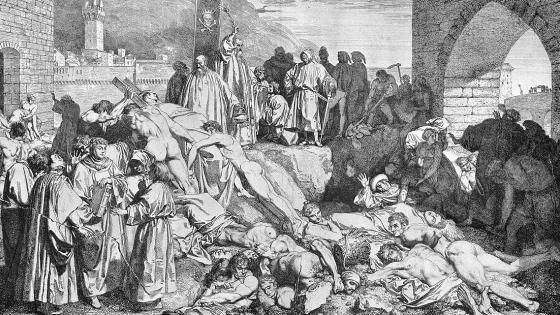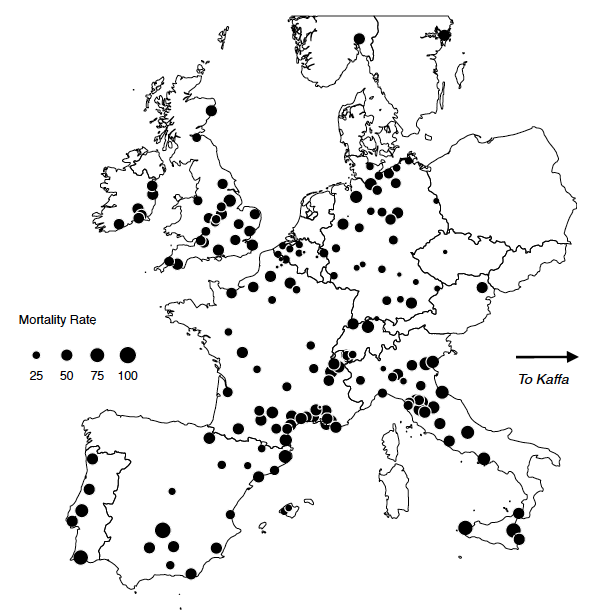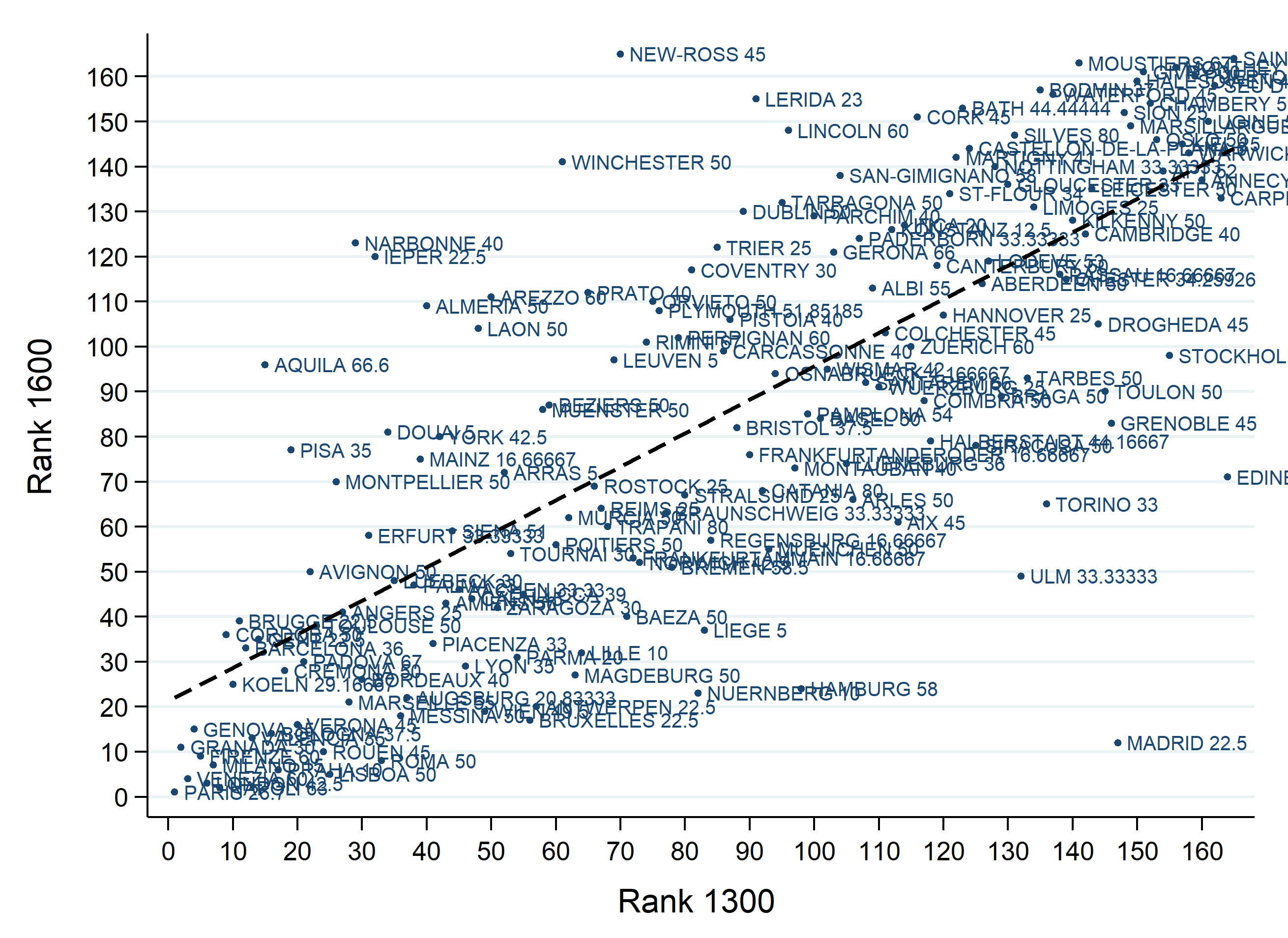The Black Death was the largest demographic shock in European history, killing approximately 40% of the region's population between 1347 and 1352. Some regions and cities were spared, but others were severely hit: England, France, Italy and Spain lost between 50% and 60% of their populations in two years. While the Black Death has been extensively studied by historians and social scientists (Benedictow 2005, Voth and Voigtlander 2013), we don't know much about its spatial effects, due to the lack of disaggregated data on mortality. Because they are so rare, we don't know much about the economic effects of any continent-wide pandemics.
Speed of recovery
Were cities and regions that were relatively harder hit by the Black Death permanently affected? We have compiled data on Black Death mortality for 165 cities, which were home to 60% of the urban population of western Europe in the 14th century (Figure 1). By combining this with information on city growth across Europe for the entire pre-modern period, we can estimate the long-run economic and spatial consequences of the Black Death (Jedwab et al. 2019).
Figure 1 Black Death mortality rates in European cities, 1347-1352 (%)
We find that between 1300 and 1400 a 10 percentage point higher Black Death mortality rate was associated with a 8.7 percentage point fall in city population, but between 100 and 200 years later, the impact of mortality was close to zero. When we examine the spillover and general equilibrium effects of the Black Death on city populations, we similarly find negative effects in the short run, and no effects in the long run. Cities and urban systems, on average, had recovered to their pre-Plague population levels by the 16th century.
Using data on historical deforestation, we find that rural areas close to higher mortality cities recovered their populations around a century after the recovery in urban populations. Data on deserted medieval villages in England show that more settlements were abandoned in low-mortality, rather than high-mortality areas – especially those far from cities. This implies that recovery in high-mortality areas was accelerated by migration from low-mortality areas, not by higher fertility and lower mortality.
Mechanisms of urban recovery
We find that urban recovery from the Black Death is entirely explained by the interacted effects of mortality with city characteristics that proxy for fixed factors of production. That is, rural fixed factors related to better land suitability, and urban fixed factors related to natural advantages (coastal access, for example) or sunk man-made advantages (such as roads) that favour trade.
Not all cities recovered at the same rate (Figure 2). Some permanently collapsed after the Black Death, whereas others gained in the long run. These permutations were associated with fixed factors, and favoured cities with better land and trade potential, and so urban systems may have become more productive.
Figure 2 Population rank of 165 cities in main sample, 1300 vs 1600
There is evidence that these results are causal. First, it is plausible that the virulence of the Plague was not related to future city growth. Second, the parallel trends assumption is verified as, prior to 1300, there was no difference in growth between areas that would be most affected by the Black Death, and those that would be comparatively less affected. Third, the results are robust to the inclusion of controls for city characteristics, region fixed effects, and contemporaneous events. Finally, our results hold when we implement instrumental variables strategies based on the facts that the Black Death entered Europe through the Sicilian port of Messina and was more virulent in its earlier stages (for pathogenic reasons), it was more lethal in cities in which it reached its peak in the summer since the fleas that transmitted the disease were more active then, and it was connectedness to Messina and not connectedness to other important cities that mattered for plague virulence.
To summarise:
- A short-run effect. The Black Death had strong spatial-economic effects in the short-run, but no such effects in the long-run. this is the first time that city-level data on Black Death mortality has been used to study its local effects, and the first time that its spatial effects have been shown to be consistent with a Malthusian model.
- Recovery of cities. Cities are often neglected in the Malthusian literature. But they were important for trade in this period, so high-mortality cities with natural or sunk man-made advantages that favoured trade were more likely to attract labour afterwards.
- Land and trade. The role of fixed factors related to land and trade in city recovery suggests that the allocation of urban populations may have improved following the Black Death.
Contemporary relevance
Understanding the economic effects of pandemics may have policy implications for today, especially given that their frequency and severity may increase with climate change. According to one recent broadcast by the BBC (2017):
“Climate change is melting permafrost soils that have been frozen for thousands of years, and as the soils melt they are releasing ancient viruses and bacteria that, having lain dormant, are springing back to life.”
Likewise, Bill Gates (2018) argues that:
“[G]iven the continual emergence of new pathogens, the increasing risk of a bioterror attack, and the ever-increasing connectedness of our world, there is a significant probability that a large and lethal modern-day pandemic will occur in our lifetime”
An uncontrolled Ebola outbreak could have dramatic economic consequences in Africa (UNECA 2015), but it is difficult to assess what those consequences would be without empirical evidence from previous pandemics.
While the Black Death took place centuries ago, our study has implications for the developing world today. Poor economies disproportionately rely on fixed factors of production similar to the ones we identify in our context (Jedwab and Vollrath 2019). This could explain why contemporary mortality increases often have positive effects (Young 2005, Rogall and Yanagizawa-Drott 2013, Esteban et al. 2015). It also suggests why population increases may have negative effects (Acemoglu and Johnson 2007, Ashraf et al. 2013). Lastly, during the Black Death Europe consisted of decentralised polities with weak state capacity. This is similar to what we can observe in poor countries today (Johnson and Koyama 2017).
References
Acemoglu, D and S Johnson (2007), “Disease and Development: The Effect of Life Expectancy on Economic Growth”, Journal of Political Economy 115(6): 925–985.
Ashraf, Q H, D N Weil, and J Wilde (2013), “The Effect of Fertility Reduction on Economic Growth”, Population and Development Review 39(1): 97-130.
Benedictow, O J (2005), The Black Death 1346–1353: The Complete History, The Boydell Press.
Christakos, G, R A Olea, M L Serre, H-L Yu, and L-L Wang (2005), Interdisciplinary Public Health Reasoning and Epidemic Modelling: The Case of Black Death, Springer.
Esteban, J, M Morelli, and D Rohner (2015), “Strategic Mass Killings", Journal of Political Economy 123(5): 1087–1132.
Jedwab, R and D Vollrath (2019), “The Urban Mortality Transition and Poor-Country Urbanization”, American Economic Journal: Macroeconomics 11(1): 223–275.
Jedwab, R, N Johnson and M Koyama (2019), “Pandemics, Places, and Populations: Evidence from the Black Death”, CEPR Discussion Paper 13523
Johnson, N D and M Koyama (2017), “States and economic growth: Capacity and constraints”, Explorations in Economic History 64: 1-20.
Rogall, T and D Yanagizawa-Drott (2013), “The Legacy of Political Mass Killings: Evidence from the Rwandan Genocide,” mimeo.
Voigtländer, N and H-J Voth (2013), “The Three Horsemen of Riches: Plague, War, and Urbanization in early modern Europe”, Review of Economic Studies 80: 774–811.
Young, A (2005), “The Gift of the Dying: The Tragedy of AIDS and the Welfare of Future African Generations”, Quarterly Journal of Economics 120(2): 423–466.







